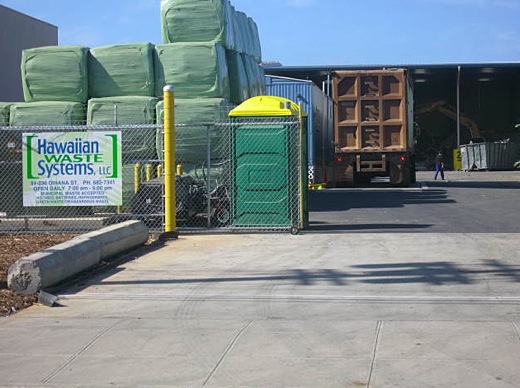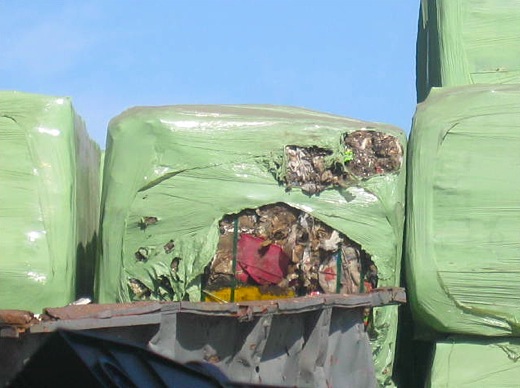SUBHEAD: Honolulu struggles to find a place for 1.6 million tons a year of garbage piled up with nowhere to go.
By Herbert Sample on 23 August 2010 for Huffington Post -
Gigantic piles of shrink-wrapped garbage have been moldering in the heat of a Hawaii industrial park for more than five months, waiting for a place to be shipped.
That wait appeared to end Monday when city officials inked a deal to dispose of the 40 million-pound pile of odious rubbish over the next six months by mostly burning it in an existing waste-to-power plant.
But bigger problems remain for Honolulu as the state's largest city struggles to find a home for all its waste.
With its lone dump filling up fast, officials had been counting on a plan to ship at least 100,000 tons of blue, plastic-wrapped garbage bales each year to a landfill near an Indian reservation in Washington state.
But the tribe vehemently objected and won a court ruling last week that put the plan on hold indefinitely. Acting Honolulu Mayor Kirk Caldwell acknowledged as much Monday.
"The city bent over backwards to try to make this shipping effort work, but it is clear that shipping is not a viable option at this time," he said in a statement.
Honolulu makes up 80 percent of Hawaii's population and generates nearly 1.6 million tons of garbage a year. More than a third of the trash is incinerated to generate electricity. The remaining garbage is sent to the 21-year-old Waimanalo Gulch landfill on the island of Oahu's southwestern coast.
But the amount of available land on Oahu is limited, with Honolulu leaders reluctant to add landfills in their backyards and near sites known for their breathtaking, pristine beauty.
And the trash can't be taken elsewhere in the state; the Big Island has by far the most vacant land, and a dump with 71 years of capacity remaining. But a local ordinance bars importation of trash from outside that island.
"Honolulu has all the elements of a form of NIMBYism on steroids," said James Spencer, associate professor of urban and regional planning at the University of Hawaii. "In fact, the only place that is not in Honolulu's backyard seems to be off in Washington state."
And Washington state, at least the part overseen by the Yakama Indian Nation, isn't having it. The tribe, by treaty, has a degree of authority over nearly 11 million acres that it ceded to the U.S. government in 1855, including a regional dump in Klickitat County.
That's where a Seattle-based firm called Hawaiian Waste Systems wanted to ship some of Honolulu's trash.
Starting last September, the trash was to be shredded and compressed into bales, wrapped in at least eight layers of thick plastic sheets and transported to the landfill, where it was to be covered with 18 inches of soil.
Tribal members were outraged that the U.S. Department of Agriculture, which regulates interstate waste transfers, granted preliminary approval to the shipments. They then went to court.
The federal government "totally ignored us, and we took issue with that," said Harry Smiskin, the tribe's chairman.
The landfill is "a rock's throw" from the Columbia River, where the tribe enjoys fishing rights, and the waterway could be affected by rodents, insects and other invasive species that hitch a ride on Honolulu's garbage, he said.
"We don't know what's in that trash," he added "We know it's not local to the environment that's there now."
The tribe and environmental groups sued the USDA in federal court and last month won a temporary restraining order, leading to the department last week revoking Hawaiian Waste System's permit before it could ship its first bale.
That frustrated company President Mike Chutz, who insisted the bales would have contained nothing ecologically dangerous because the plastic wrapping deprives oxygen to anything living inside.
"I know in my heart that this is absolutely not only acceptable but environmentally safe and will (do) no harm whatsoever to the environment," Chutz said last week.
Because of repeated delays in the shipping plan, hundreds of trash bales collected in the company's facility in a Kapolei industrial park – far from the eyes of tourists and residents. A few of the 4- to 5-foot tall bales are in shipping containers, but far more sit stacked three and four high, some sprouting tears, holes and other signs of weathering.
Monday's agreement between the city and Chutz' firm requires the garbage that cannot be burned to be sent to the Waimanalo Gulch landfill, which must close by July 2012.
Around that same time, the city hopes to start operating a third trash furnace at its electricity-generating plant in Kapolei, allowing the burning of about 902,000 tons a year.
Still, that leaves this island with a lot of garbage generated from some 907,000 residents, 51,000 military service members and families, and an average of 80,000 tourists a day. They produced almost 1.6 million tons in the fiscal year that ended June 30, a drop from the 1.8 million tons the previous year that is largely due to the recession and a decline in tourism.
The city is forming a panel to search for new landfill sites. But that process could take years, and is fraught with political and cultural implications, Spencer said.
"Honolulu has placed its sole landfill on the Leeward Coast of Oahu, a generally poor and disproportionately Native Hawaiian area," he said.
"It is ironic that the original destination (of the trash going to Washington state) was next to Indian tribal land, and the default destination is likely to be the Waimanalo Gulch, next to the largest concentration of Native Hawaiians on Oahu."
.


1 comment :
Mufi done a good job with this. What he done for Honolulu, he can do for the state.
Post a Comment